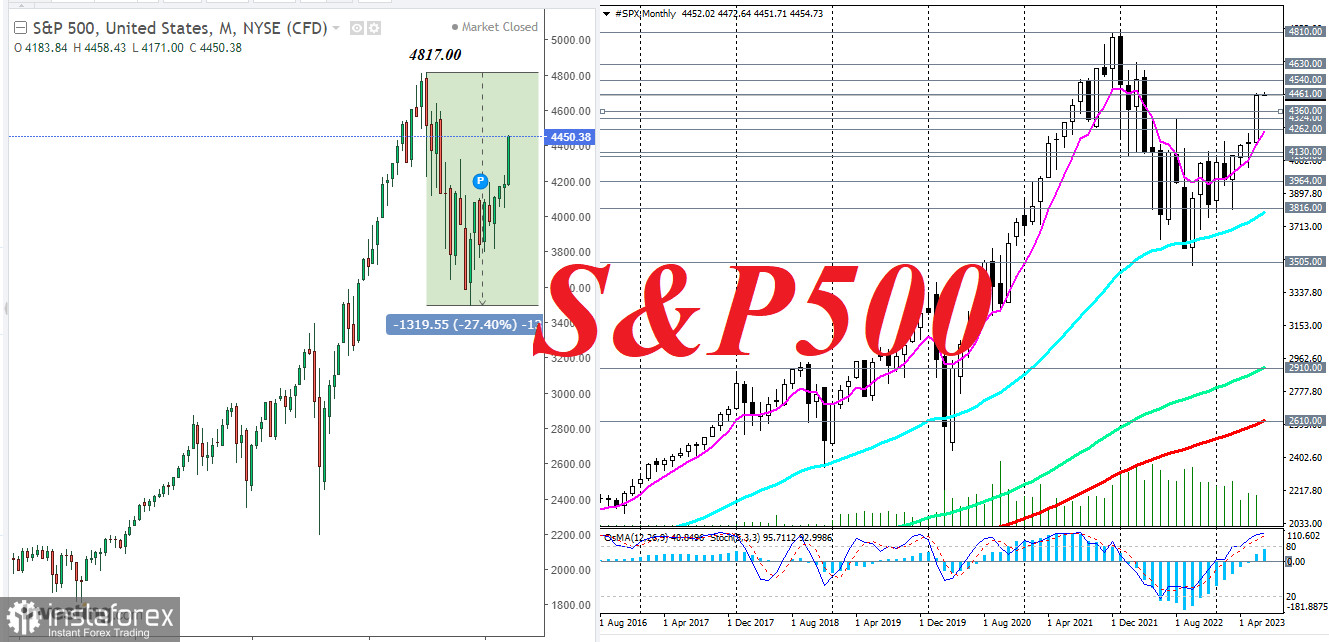
Despite expectations of two more interest rate hikes by the Federal Reserve, major American stock indices ended the past month, quarter, and first half of the year on a positive note.
Speaking at the ECB Forum last week, Federal Reserve Chair Jerome Powell confirmed the central bank's intention to raise interest rates at least twice more by year's end.
According to him, the Fed's fight to lower inflation to its 2% target "has a long way to go." "It will take time, however, for the full effects of monetary restraint to be realized, especially on inflation," he added.
Expectations of further interest rate increases by the Federal Reserve continue to drive the dollar up. However, this does not hinder a rally in the US stock market, which has received support from positive macroeconomic statistics released in June and last week.
According to the final data, the US economy grew at a 2.0% annualized pace in the first quarter, well above the preliminary estimate of 1.3%. The upward revision helped undercut widespread expectations of a looming recession in the country.
Equally important data released last week showed that new orders for durable goods rose by 1.7% in May, while orders for non-defense capital goods excluding aircraft increased by 0.7%.
At the same time, the Conference Board's report based on the survey of around 3,000 American households indicated a high level of consumer confidence (109.7 compared to the previous indicator values of 102.3, 101.3, and 104.2). In addition, the University of Michigan's consumer sentiment index was revised from 63.9 to 64.4 in June (compared to the forecast of 63.9 and the previous values of 59.2 and 57.7).
These figures are leading indicators of consumer spending, which accounts for a majority of overall economic activity, and the high level of consumer confidence indicates economic growth.
Economists believe that the US economy is immune from the risk of a recession due to several mechanisms, including active job creation, high corporate profitability, a decrease in household savings rates in the US, as well as government programs supporting investments and energy transition.
Last Friday marked the final chord of the trading month. Investors were encouraged by data on the personal consumption expenditures (PCE) price index, which confirmed easing inflation. This, in turn, may force Fed officials to prolong their wait-and-see approach and refrain from further interest rate hikes.
As for the possibility of two more rate increases this year, Fed Chair Jerome Powell noted that no final decision had been made regarding the July meeting. "We don't want to overdo it," he said. "We will continue to make our decisions meeting by meeting, based on the totality of incoming data and their implications for the outlook for economic activity and inflation, as well as the balance of risks," the head of the Fed added.
In this regard, market participants also took note of a statement by Federal Reserve Bank of Atlanta President Raphael Bostic last week. He emphasized the need to keep monetary policy parameters unchanged at the July meeting as inflation expectations are lower than the June figures.
Investors were also encouraged by the results of the Federal Reserve's bank stress test conducted last week. It showed that nearly all major US banks are capable of withstanding a severe economic downturn with their current liquidity reserves, and the Fed is ready to provide immediate support in case of extraordinary situations and shocks.
In other words, there are currently more reasons for further growth in US stock indices than for their decline.
Today's macroeconomic calendar includes a new batch of statistics on the US economy which is expected to be upbeat. Traders may take notice of S&P Global's final assessment of business activity in the manufacturing sector and the ISM's Manufacturing Purchasing Managers' Index (PMI).
According to the Institute for Supply Management, the manufacturing PMI is expected to rise to 47.2 in June from 46.9 in the previous month, while the new orders index may contract to 44.0 from 42.6 in May.
Although the indicators are below the 50 reading, which separates growth from contraction, their relative increase may support both the dollar and US stock indices.
If the actual readings turn out to be worse than forecasts, the US stock market, particularly Wall Street's benchmark S&P 500 index, may enter a downward correction.
This week, the focus of market participants will be on the US Labor Department report to be released on Friday, which will provide data for June.

From a technical point of view, the S&P 500 index is trading upwards within the global bull market. It is significantly above the support levels of 2,910.00 and 2,610.00, which separate the global bull market from the bear one. A confirmed breakout above the June high of 4,461.00 could generate a buy signal.
*) copying signals at InstaForex -
https://www.instaforex.comforexcopy_system
**) PAMM system at InstaForex -
https://www.instaforex.compamm_system
***) open a trading account with InstaForex -
 English
English 
 Русский
Русский Bahasa Indonesia
Bahasa Indonesia Bahasa Malay
Bahasa Malay ไทย
ไทย Español
Español Deutsch
Deutsch Български
Български Français
Français Tiếng Việt
Tiếng Việt 中文
中文 বাংলা
বাংলা हिन्दी
हिन्दी Čeština
Čeština Українська
Українська Română
Română

